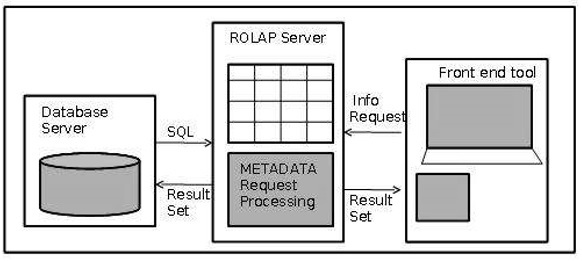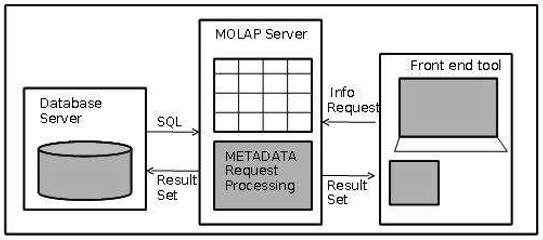Data Warehousing Relational OLAP
Relational OLAP servers are placed between relational back-end server and client front-end tools. To store and manage the warehouse data, the relational OLAP uses relational or extended-relational DBMS.
ROLAP includes the following:
- Implementation of aggregation navigation logic
- Optimization for each DBMS back-end
- Additional tools and services
Points to Remember
- ROLAP servers are highly scalable.
- ROLAP tools analyze large volumes of data across multiple dimensions.
- ROLAP tools store and analyze highly volatile and changeable data.
Relational OLAP Architecture
ROLAP includes the following components:
- Database server
- ROLAP server
- Front-end tool.

Advantages
- ROLAP servers can be easily used with existing RDBMS.
- Data can be stored efficiently, since no zero facts can be stored.
- ROLAP tools do not use pre-calculated data cubes.
- DSS server of micro-strategy adopts the ROLAP approach.
Disadvantages
- Poor query performance.
- Some limitations of scalability depending on the technology architecture that is utilized.
Data Warehousing – Multidimensional OLAP
Multidimensional OLAP (MOLAP) uses array-based multidimensional storage engines for multidimensional views of data. With multidimensional data stores, the storage utilization may be low if the data set is sparse. Therefore, many MOLAP servers use two levels of data storage representation to handle dense and sparse data-sets.
Points to Remember:
- MOLAP tools process information with consistent response time regardless of level of summarizing or calculations selected.
- MOLAP tools need to avoid many of the complexities of creating a relational database to store data for analysis.
- MOLAP tools need fastest possible performance.
- MOLAP server adopts two level of storage representation to handle dense and sparse data sets.
- Denser sub-cubes are identified and stored as array structure.
- Sparse sub-cubes employ compression technology.
MOLAP Architecture
MOLAP includes the following components:
- Database server.
- MOLAP server.
- Front-end tool.

Advantages
- MOLAP allows fastest indexing to the pre-computed summarized data.
- Helps the users connected to a network who need to analyze larger, less-defined data.
- Easier to use, therefore MOLAP is suitable for inexperienced users.
Disadvantages
- MOLAP are not capable of containing detailed data.
- The storage utilization may be low if the data set is sparse.
MOLAP vs ROLAP
| Sr.No. | MOLAP | ROLAP |
|---|---|---|
| 1 | Information retrieval is fast. | Information retrieval is comparatively slow. |
| 2 | Uses sparse array to store data-sets. | Uses relational table. |
| 3 | MOLAP is best suited for inexperienced users, since it is very easy to use. | ROLAP is best suited for experienced users. |
| 4 | Maintains a separate database for data cubes. | It may not require space other than available in the Data warehouse. |
| 5 | DBMS facility is weak. | DBMS facility is strong. |

